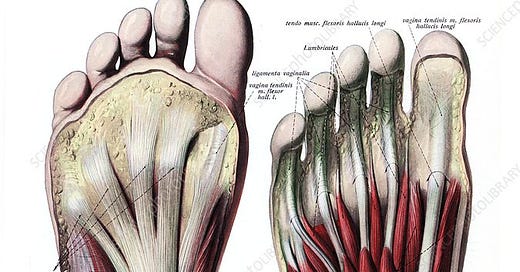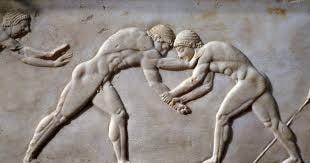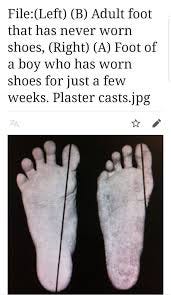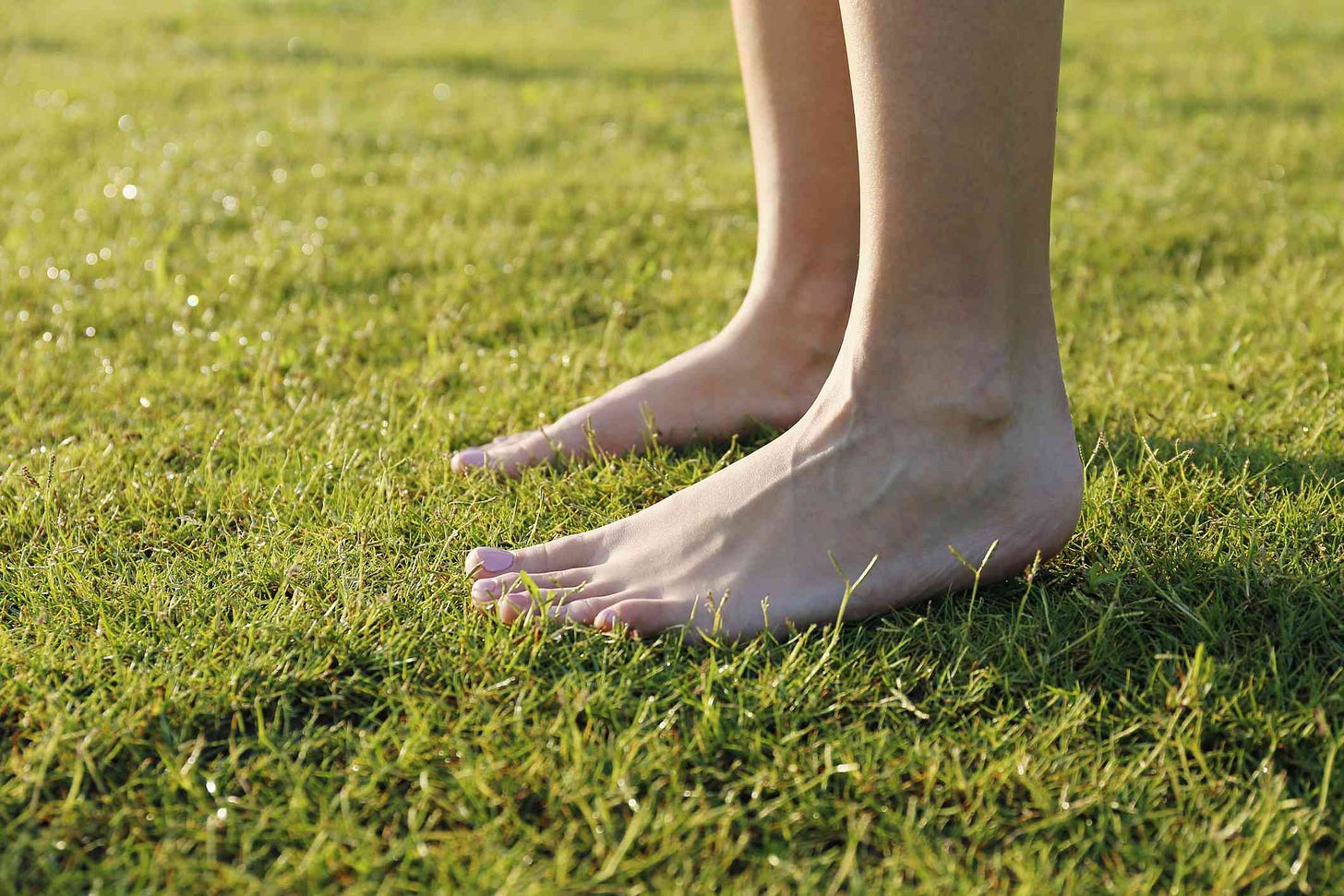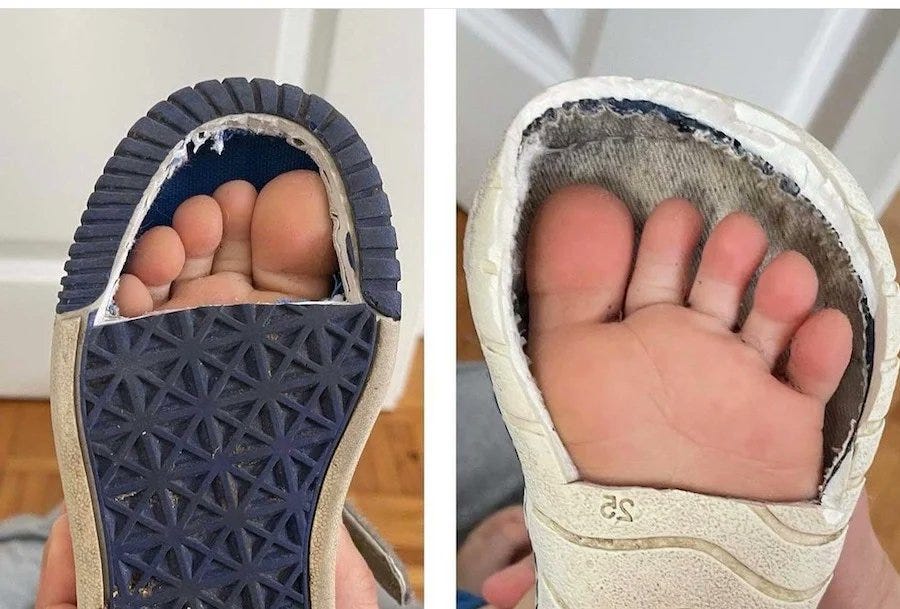Unshackled: How Barefoot Shoes Are Reclaiming What Modern Footwear Has Stolen
The Case Against Modern Shoes and the Rise of Barefoot Footwear
Your feet tell you your story, both physically and spiritually.
In times today where everything is boosted by consumerism, we have seemed to have completely neglected ourselves and have opted to be materialistic - a factor towards “The Great Decline Of Man.
Amongst the many different aspects that we have neglected, this one will come as a surprise to you. YOUR FEET. Yes you read that right. YOUR FEET.
You may not know it, but your feet are so important to your overall health. And I cannot stress this enough. Imagine if you didn’t have feet, or that you couldn’t use your feet. All the things which you take for granted now, would leave you feeling journey-less if you didn’t have feet to use. Yes that was a play-on words.
If you are to look down at your feet now and analyse them, do you think they are in the best condition that they could be in? I will give you your answer.. NO.
This article will walk you through the powers of your feet and will take you on a journey to the wisdom that comes from your feet.
What are feet made up of?
Our feet are made up of complex structures compiled from 26 bones, 33 joints, over 100 muscles; tendons & ligaments, nerves and blood vessels and of-course skin.
Bones:
The bones that make up our feet (26 in total for each foot) are the Tarsal Bones (back of the foot), Metatarsal Bones(long bones) and the Phalanges (bones in your toes).
Joints:
The joints in our feet and in our body in general, allow for movement and flexibility. The joints in our feet allow for us to pivot, for gripping and obviously for balance.
Muscles:
The muscles in our feet help with maintaining our balance as well as spreading the toes - will touch on the importance of this further down this article.
The muscles in our lower leg have a direct impact in controlling our movements that stem down to our feet. Movements such a walking, running and jumping.
Tendons:
The role of tendons is to connect muscles to bones. The achilles tendon connects the calf muscle to the heel. This tendon is very crucial when it comes to walking and running. If only Achilles wasn’t dipped into the lake of Styx by his Achilles Tendon and was submerged into it. This is how this tendon got its name.
Ligaments:
Ligaments are tissues that connect bones to other bones. This helps to provide stability.
Nerves:
As we know, our nerves enable us to feel different sensations. When it comes to our feet, this helps with touch and pain and how to perform different movements.
Skin:
Our skin is the largest organ in the body. The skin on our feet has connective tissue located underneath it which acts as a cushion for the bones in your feet.
What did our ancestors wear? How were their feet stronger? Metal souls on shoes - esoteric healing from the earth
Many different people spanning across the globe throughout the many years gone by, did not, well at least most of them didn’t, wear some type of shoes that confine your feet and provide no breathing space between the toes.
But what did they wear? It is well documented that some cultures and peoples would have worn something similar to sandals. This provided them protection for the souls of their feet, whilst still enabling them to manoeuvre how they normally would. Many people would have still gone barefoot for sometimes. This would’ve provided them with some very strong feet as they would have walked over many different terrains.
Furthermore, as we know with the ancient Greeks, in their gymnasiums when they were training, as well as the Olympics, they trained fully naked. This also meant that they would’ve trained without anything on their feet. This would have greatly strengthened their feet and they are probably laughing about how weak our feet are today.
Think about this. When you train different muscle groups, you put those selected muscles through a source of pain in order for the muscle to adjust to the pain receptor, and for the muscle to come back bigger and stronger. The same thinking has to be applied to our feet.
Some cultures from Asia installed metal plates at the bottom of the soles on their shoes. Why? Because the metal would be able to further enhance the production of positive electrons from the earth. This obviously boosted their health as it is as if they are grounding the whole time. It wasn’t too long ago that caines had metal at the bottom, but were quickly replaced with rubber? Rubber doesn’t conduct electricity, where as the metal does. This ties in with free energy and energy from the earth. Hmmmm, I wonder why they stopped this (the answer is it’s healing benefits and it was changed to make us weaker).
The problem with modern shoes
If you are to look at the toe box of your shoes you will see that they are very narrow.
The soles of the shoes are made of foam
They aren’t made from good material
Very pricey
Not designed to FIT YOUR FOOT
All of these factors to an unhealthy and weak foot. Our feet are responsible for the overall health of our body. They directly relate to our posture and how we move.
Modern shoes have completely hindered us. If you are to look down at your feet and think that they are fine, trust me, I guarantee you that they are far from okay. But how do I know this? I speak from experience. I used to wear these “modern shoes” all the time from trainers to work shoes to football boots every week. And since doing some research into the subject matter and buying my own pair of barefoot shoes, I have never been able to look at footwear the same.
Now, I know for some of you that when it comes to work, you may not have a choice and may end up wearing shoes that are a hindrance to you. But, what I will say to you is that, when you are not at work wear/buy trainers that have a wide toe box (or barefoot shoes or grounding shoes), walk around at home in your bare feet, or wear toe socks and do not train with gym/running shoes - absolute now go. For someone like myself, working in the construction industry, I have managed to fine a pear of wide-toe-box steel-toe-cap boots. The lesson from this:
“Where’s there’s a will, there’s a way”
I live by this quote thanks to my Dad :)
My experience with barefoot shoes
As mentioned in the above subsection, they have changed my life for the good. The biggest difference I noticed at first was walking in barefoot shoes. It did take some getting used to as there is far more space to play with and due to the fact that they are near enough flat, you are feeling every terrain you’re walking on (this is excellent). The next thing I noticed was training in them. I noticed a big difference when it came to squatting, deadlifting, sprinting or anything explosive which required me to drive from & through my feet. Barefoot shoes from my experience are very durable and have not failed me.
Since moving to barefoot shoes I haven’t looked back since. Whenever I have to put on some footwear where there is a very narrow toe-box, it makes me feel uncomfortable and that I haven’t got room to move and for my feet to feel free. I have noticed that my feet do feel more stronger now since wearing barefoot shoes. I have also noticed that my toes spread apart more now due to the transition to barefoot shoes.
I honestly can’t recommend it enough to people. Change to barefoot shoes and your life will be changed… forever.
What are the negatives?
From my experience, it took my feet about 2 weeks to adjust to them. I had these pimples that are similar to blisters on my toes - I do not know whether anybody else had the same problem - maybe because I was not wearing socks at all. But after that, my toes were completely fine.
Pricing. The shoes can be pricey. I have bought my barefoot shoes from Vivobarefoot and they do cost quite a bit. I you have the money they I would highly recommend getting a pair. But, there are also other websites that sell barefoot/grounding footwear.
Foot strength
How can you improve the strength of your feet? What should yo do?
These are the (7) things I would do to improve the strength of my feet":
Wearing barefoot/grounding shoes whenever possible - ESPECIALLY WHEN TRAINING
Walk around your house in bare-feet or with toe socks or barefoot shoes
Jump, Jump and Jump so more - skipping is KEY
Practice squatting with your heels rails and driving through your toes - I have seen a significant difference when implementing this
Walk over different terrains, rocky and uneven ground, a walk in the woods
Sprinting
Grounding - Grass, Sea, Sand anything from the ground that is natural
Why is it important to go barefoot?
What is Grounding?
Grounding, or earthing, is where you connect with the electricity/energy of the earth. This typically involves us walking barefoot as well as using our hands. But mainly our feet. The way for you to do grounding is to go outside and place your bare-feet and hands on some grass or the earth. And you can also do this on some sand by the beach as well as immersing yourself in the sea or a lake that is clear of any toxins.
As alluded to previously, training barefoot outside on some grass or sand, will greatly enhance the health of your feet, as well as your overall health, and it will make your feet much stronger as well as being exposed to the sun for some essential Vitamin D (this depends on where you live in the world and what time of the year you are training outside).
GO BAREFOOT, OR FOREVER SUFFER THE CONSEQUENCES
Studies
Barefoot running: biomechanics and implications for running injuries
“Barefoot running encourages a forefoot strike pattern that is associated with a reduction in impact loading and stride length. Studies have shown a reduction in injuries for forefoot strike patterns. Barefoot running also affords the runner increased sensory feedback from the foot-ground contact, as well as increased energy storage in the arch.”
Habitual Habitual footwear use has been reported to influence foot structure with an acute exposure being shown to alter foot position and mechanics. (Fifteen of 466 articles met the predetermined inclusion criteria and were included in the review)
Walking barefoot enables increased forefoot spreading under load and habitual barefoot walkers have anatomically wider feet. Spatial-temporal differences including, reduced step/stride length and increased cadence, are observed when barefoot. Flatter foot placement, increased knee flexion and a reduced peak vertical ground reaction force at initial contact are also reported. Habitual barefoot walkers exhibit lower peak plantar pressures and pressure impulses, whereas peak plantar pressures are increased in the habitually shod wearer walking barefoot. Footwear particularly affects the kinematics and kinetics of gait acutely and chronically.
How barefoot and conventional shoes affect the foot and gait characteristics in toddlers
Objective: Barefoot shoes have become a popular alternative to modern shoes. The aim of the study was to compare the foot of toddlers, as well as their gait pattern when wearing conventional shoes & barefoot shoes since their first steps.
Methods: 30 toddlers, 15 wearing barefoot shoes and the other 15 wearing conventional shoes. The first data collection session occurred within one month after the first five consecutive unsupported steps were performed by the toddler. The second data collection session occurred seven months after this event. At each data collection session, the toddler was instructed to walk barefooted at its natural speed.
Results: The results of this study show a higher plantar arch and a smaller foot progression angle in the BF group. The forefoot width in both the BF and N-BF groups remained proportional to the foot length after seven months of independent walking.
Conclusions: These findings may encourage parents and caregivers to introduce barefoot shoes or create a habitual barefoot time for their child.
Walking barefoot vs. with minimalist footwear – influence on gait in younger and older adults
Background: In recent years, minimalist footwear has been increasingly promoted for its use in sportive and recreational activities. These shoes are considered to function naturally like barefoot walking while providing a protective surface.
Methods: In a randomized within-subject study design, 31 healthy younger (29 ± 4 years) and 33 healthy community-dwelling older adults (71 ± 4 years) volunteered. Participants walked on flat ground, once barefoot and once with minimalist shoes. Gait variability of minimum toe clearance (MTC), stride length, stride time, and local dynamic gait stability were analysed.
Results: The results for both age groups showed significant condition effects (minimalist shoes vs. barefoot walking) for the outcomes of local dynamic stability (p = .013), MTC variability (p = .018), and stride length variability (p < .001) indicating increased local dynamic stability and decreased gait variability during the minimalist shoe condition. Group effects (young vs. older adults) were detected in all gait outcomes.
Conclusion: Walking with minimalist shoes appeared to be associated with better gait performance than walking barefoot in both age groups. Thus, walking with minimalist shoes is not similar to barefoot walking.
This study demonstrates for walking in a straight line on flat ground that minimalist shoes, as compared to walking barefoot, have significantly different effects on gait and fall predicting parameters such as gait stability (LDS) and variability (MTC). Effects were observed for the group of younger as well as older adults. Walking with minimalist shoes was overall associated with better gait performance than walking barefoot. This finding hence demonstrates the potential of minimalist shoes as a means to prevent falls.
Conclusion:
From what I have presented to you in this article, I believe that barefoot will pave the way for a brighter future for you. The benefits of barefoot shoes, and simply training and being active whilst barefoot, range from improved food strength, increased running efficiency, better balance, improved gait, better ankle mobility and much more.
My experience from barefoot shoes has only been positive and I echo my experiences to any one else who asks me about barefoot shoes as well as their interest in buying/converting to barefoot shoes.
If you are still questioning the credibility of this subject matter, there are multiple studies regarding this for you to latch your claws into.
What’s next for you?
Start training with barefoot shoes as well as training or at least walking around at home barefoot. Strengthen your feet and your health will improve. Our feet benefit us in many more ways that you could imagine. DO NOT NEGLECT THEM. SUPPORT THEM. Your feet will take you onto the path that is destined for you, tread carefully but with full aggression.
Health Is Wealth
*Not medical advice. Do your own research*
